You’ve heard the saying loads of times… Great wine starts in the vineyard. It is said by so many vintners because it is true. Vine balance is extremely important to producing excellent fruit. There is a concept known as vine balance. It is the balance between the vegetative (green) state and the reproductive (fruit) state of the vine. We measure the reproductive growth as yield and the vegetative state as pruning weight.
Many things can affect this balance. The amount of sunlight, the amount of water… these are the more obvious ones. What is often overlooked, is the health of the soil itself. The nutrients that are in the soil have a direct impact on the vine’s health. (This is where the biodynamic farming focuses)
Way back in 1828, agricultural scientist, Carl Sprengel developed the law of minimum. This concept was later popularized by Justus von Liebig, a German chemist. Liebig’s law of the minimum demonstrated that the essential plant nutrients carbon, oxygen and hydrogen are absorbed from the air, whereas other nutrients are typically obtained from the soil. Grapevines (as do we) require two types of nutrients. Micro and Macro.
Macronutrients: nitrogen (N), phosphorus (P), potassium (K), calcium (Ca), sulfur (S), magnesium (Mg), carbon (C), oxygen(O), hydrogen (H)
Micronutrients (trace minerals): iron (Fe), boron (B), chlorine (Cl), manganese (Mn), zinc (Zn), copper (Cu), molybdenum (Mo), nickel (Ni)
Macronutrients are consumed in larger quantities and contribute to over 95% of a plants’ entire biomass (dry matter weight). Micronutrients are present in the plant tissues in quantities measured ranging from 0.1 to 200 ppm (parts per million), or less than 0.02% dry weight. Both macro and micro nutrients have a tremendous impact on the health of the vine.
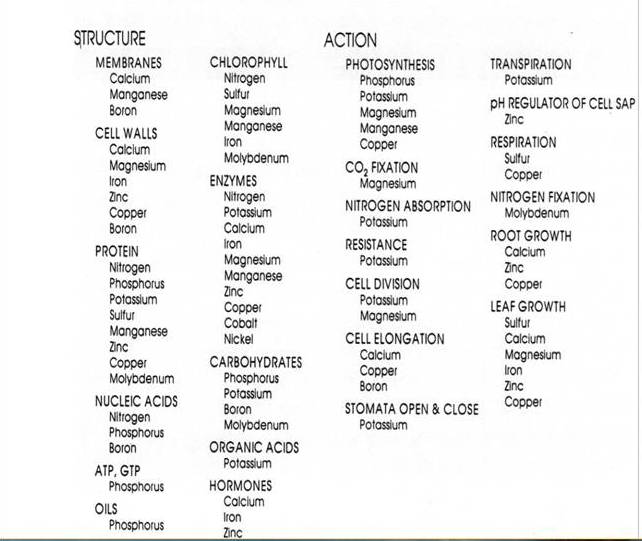
Potassium (K) Deficiency

Potassium deficiency develops when vines receive less K than what is required for normal growth and development, or with low soil pH levels (i.e., less than 5 for Vitis vinifera) that decrease the availability of potassium to the roots. Potassium is a mobile nutrient and in the case of deficiency, the upper (younger) leaves receive K rather than the lower (older) leaves, therefore reddening the leaves in the lower part of the canopy first.
Magnesium (Mg) Deficiency
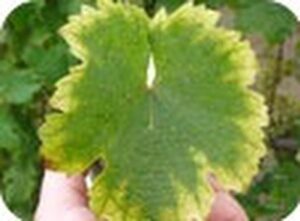
Magnesium is an essential part of chlorophyll and aids in the formation of sugars, oils and fats. Magnesium deficient vines have older leaves that are pale in color. Early on in the season, Mg deficiency shows itself as small brown-green spots near the margins and in the interveinal tissues of young, growing leaves. Later on, straw yellow tissue between the main veins and Some of the affectedleaves will maintain a halo of green on their margins.
Iron (Fe) Deficiency
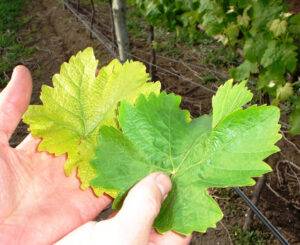
Iron deficiency shows up in the youngest leaves first as pale leaves. This is often called lime induced chlorosis. Although Iron deficiency is generally rare because most soils contain enough Fe to meet the requirements of grapevines. The availability can be limited due to the alkaline limestone rock underneath locking up iron not allowing the grapevines to take the iron up. Iron nutritional problems are generally fixed once the weather warms up and vine uptake increases.
Nitrogen (N) Deficiency
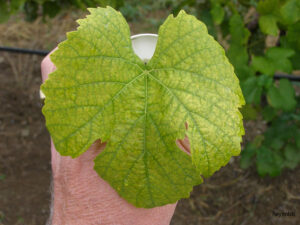
Nitrogen is an extremely important nutrient to the grapevine. When deficient it can cause low vine vigor. The leaves turn pale green then progress to yellow. The younger shoots can become pink or red. Necrosis can also happen and is identified as light brown islands of dead tissue appear between the main veins of the basal leaves and they may wilt. The shoot growth is also greatly reduced and the berries tend to be small.
Dracaena Wines has received consistent 90+ ratings and multiple Double Gold medals. Click image to order yours today and let Dracaena Wines Turn Your Moments into Great Memories!
Phosphorus (P) Deficiency

Phosphorus is considered second only to nitrogen as the most essential nutrient to grapevine function. It is used in photophosphorylation, genetic transfer, the transportation of nutrients, energy production and the creation of the phospholipid cell membranes. Phosphorus deficiency shows a very distinct symptom that appears as red dots along the basal leaves, mid and terminal lobes. Over time the dots line up at right angles to each other and form dark red bars between the veins. The leaves can ultimately become hard and stiff.
Calcium (Ca) Deficiency

This is a little different from many of the other nutritional deficiencies in that it not so obvious in the leaves, but more obvious in the resulting fruit. Since Calcium regulates ripening of fruits and stimulates their coloring the result of a deficiency is a browning discoloration and rotting on the tips of grapes. The grapes will then desiccate and ultimately lead to fruit necrosis.
Boron (B) Deficiency
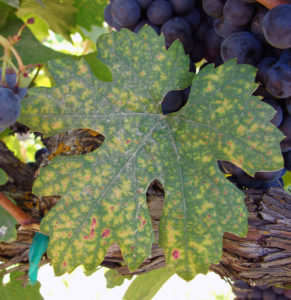
Boron is important for flowering, fruit set and helps with even fruit ripening. It is one of the most serious nonparasitic grapevine diseases and is most prominent in strongly acid soils (pH 3.5 – 4.5). There are plenty of signs that the vine is deficient in Boron. You typically see short internodes and mottled or patched chlorosis in the leaves. There typically is poor (or even no) fruit set and the shoot tips can die off. Unlike many of the other micronutrients, Boron is unique in the fact that there is a narrow range between deficiency and toxicity in soil and vine tissues.
Nitrogen (N) Deficiency

N is mostly acquired by plants in the nitrate and ammonium forms and for a small part as small organic molecules (e.g. amino acids, urea.) Nitrogen is important for many vine functions including not only the overall growth, but fruit formation, set and size.
Nitrogen is necessary for many vine functions, including overall vine growth, fruit bud formation, fruit set and fruit size. Therefore, a vine that is deficient in Nitrogen can show low vine vigor. The leaves will turn a pale green and then ultimately yellow, while young shoots and petioles can become pink. The berries tend to be small and shoot growth greatly reduced.
Zinc (Zn) Deficiency
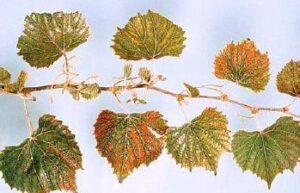
Zinc deficiency tends to show first in younger leaves. Deficiency can stunt growth and lead to the development of small leaves with a widened petiolar sinus. The leaves also show chlorosis within the spaces between the veins. There may also be necrotic spots and leave roll.
During our studies at UC Davis, I loved the classes that discussed the vines themselves and the soil. Winemaking is a blend of both science fields, Chemistry and Biology. I think that’s what makes it a great match for Mike and myself. He’s the chemist and I’m the biologist. Two sides of the brain working together to create the best wines.
I’d love to hear your thoughts on the science of wine. Just leave me a comment!
Sláinte!
Try the 90+ rated and multiple Double Gold medal winning wines of Dracaena Wines and get a 10% discount off your first order. Click the banner below. Use code “Explore” at checkout. 
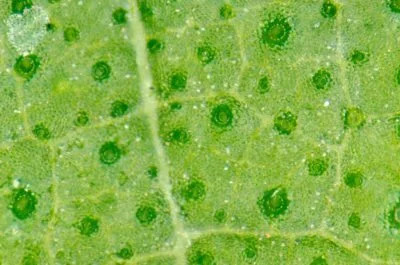
I spent a few hours yesterday studying this very topic, and your explanations make much more sense to me than the ones in my textbook! Cheers Lori!
Oh my gosh! Thank you and I’m so happy I could help you!!
Great breakdown of different nutrient deficiencies. Thank you!
Thanks Michelle!
Very well explained and feeds our inner wine geeks…thank you!
Thanks Allison. Wine geeks unite!
Wow very interesting to read – I’ve learnt a lot. Thanks guys!
Thanks Casey.. Glad the post was informative.
Woah, I didn’t know that vines could suffer from so many different deficiencies. Great explanations of each one.
My friend also studied to be a winemaker at UC Davis and she is now married to a winemaker and lives here in Bordeaux (specifically Saint-Émilion).
Oh I love Saint Emilion! That must be so exciting to live there and be part of that wine world! Thanks for reading Jennifer.
I am bookmarking this! What a great concise breakdown on this subject! We talk about how the soils affect the taste of the wine, we sometimes forget how they can also affect the growth of the vine that makes the grapes for that wine. Speaking with vintners I am always impressed with how they say the vines “speak” to them. The vines have all these tells to let you know what they need. Amazing and fascinating!
Thanks Robin. Yes, the vines talk. They do try to tell you all you need to know in order to make them happy!
Definitely bookmarking this breakdown for when I start planting my own vines hopefully in the very near future! Very well thought out piece.
Thank you very much! Good luck with the plantings!